Chapter: Electrical and electronics : Circuit Theory : Network Reduction and Network Theorems for DC And AC Circuits
Important Short Questions and Answers: Network Reduction and Network Theorems for DC And AC Circuits
1.
State Thevenin’s. theorem
Any complex network consisting of linear, bilateral and lumped elements can be replaced by a simple circuit consisting of single voltage source in series with resistance. It is also called as Helmholtz’s. theorem
2.
State Norton’s. theorem
Any complex network consisting of linear, bilateral
and lumped elements can be replaced by a simple circuit consisting of single
current source in parallel with resistance.
3.
State Superposition theorem.
In a linear, bilateral and lumped circuit elements
that is energized by two or more sources, the response(current through or
voltage across) in any resistor is equal to individual responses in it, when
sources acts separately.
4. State Maximum power transfer theorem.
It
states that the maximum power transferred to the load occurs when the load
resistance is equal to the source resistance (equivalent resistance).
Condition
for maximum power transfer RL = R
5. State Reciprocity theorem.
It states that in a linear, bilateral,
single source circuit, the ratio of excitation to response is constant when the
position of excitation and response are interchanged.
6.Draw
the Thevenin’s equivalent
circuit.
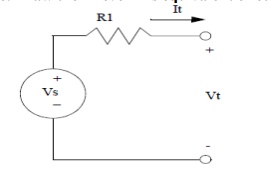
7. Draw the Norton’s equivalent
circuit
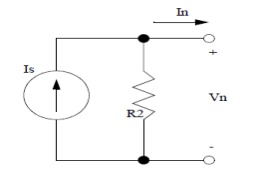
8.
What are
the applications of
Thevenin’s theorem?
1. To find the particular branch current in an
electrical network while the resistance of that
branch
is varied with all other elements of the network remaining unchanged.
2. Used
in sensitivity analysis.
9.
What are
the advantages of
Thevenin’s theorem?
1. Applicable
to circuits containing any type of load –linear or non linear or time varying.
2. Applicable
to circuits with load containing sources.
3. Applicable
to circuits with load having initial conditions on passive
elements.
10.What
are the limitations
of Thevenin’s theorem?
1. Load
should be connected to network containing linear elements only.
2. There
should be no controlled source or magnetic coupling with the elements of load.
11.What
are the applications of Maximum power transfer theorem? (AU-MAY08)
1. It
is used for impedance matching.
2. It
is used in communication circuits, where the power or circuit currents are low.
12.What
are the limitations of Reciprocity theorem?
1. Only
one source is present in the network.
2. Initial
conditions should be zero.
3. The
network is linear.
4. Impedance
matrix is symmetric.
5. Dependent
sources present in the network, even if they are linear, are excluded.
13.under
what conditions, the super position theorem may be applied to the circuit.
It is applicable to all time variant linear networks. It holds good for all possible locations, types and waveforms of the independent systems. The theorem applies both in time domain and frequency domain.
15.
Write short notes about superposition theorem.
It is valid only for linear circuits. It
is not valid for power responses. When the superposition theorem is applied to
any circuit. the dependent voltage source in the circuit is always active.
16. State
under what circumstances Thevenin’s
Thevenin’s equivalent circuit is useful
in particular branch current in a network as the resistance of that branch is
varied while all other
resistances
and sources remain constant.
17.
What is meant by short and open circuits?
A short is conductor with zero resistance and an
open is an infinitely large resistance. When we short circuit the resistance we
replace the resistance by a conductor with zero resistance and when we open the
circuit a resistance we remove the resistance.
18. Find the current through 10 Ω
resistor in the following circuit.

19. Determine the current through 1
Ω and 4 Ω resistors.

20.
Find the current I in the circuit.
When 2A source is acting alone.

When
both sources are acting together I=2A
21. Find the thevenin’s equivalent for the
circuit shown.
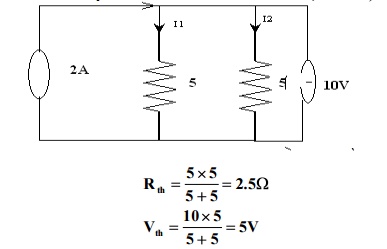
22.Find
the Norton’s equivalent. for
the circuit shown.
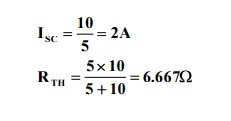
23. Find the value of RL for
maximum power transfer.
Condition for maximum power transfer RL=RTH

24.
What is the property of additivity and homogeneity?
The
principle of super position is a combination of additivity and homogeneity.
The property of addivity says that the
response in a circuit due to number of sources is given by sum of response due
to individual sources acting alone.
The property of homogeneity says that if al the
sources are multiplied by a constant, then the response is also multiplied by
the same constant.
25. By using superposition theorem, find
the current through the ammeter.
Response due to 10V source I1
Response due to 5V source I 2
Total response = I
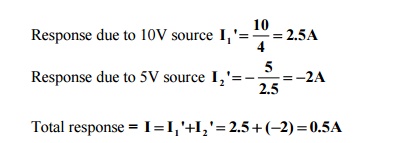
Related Topics